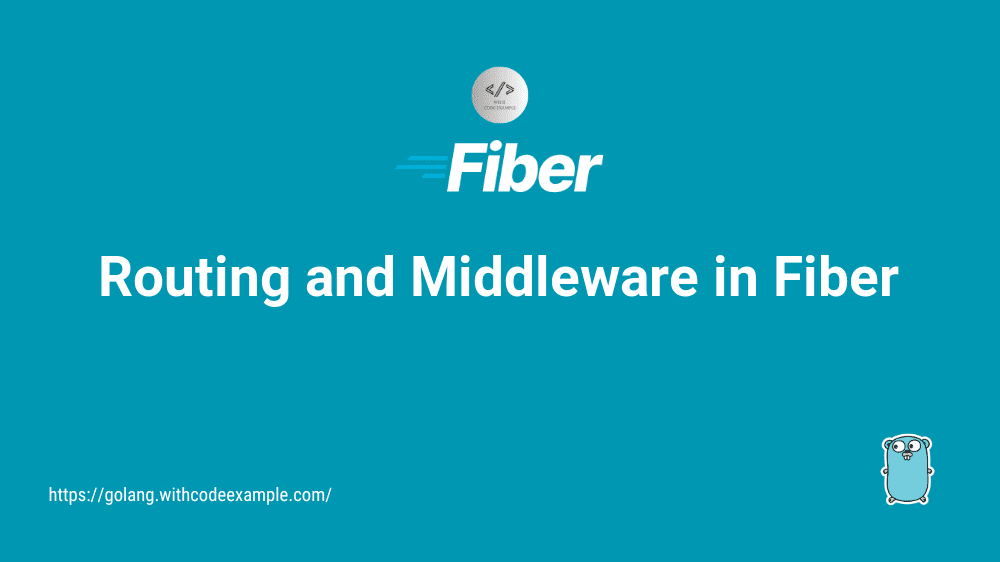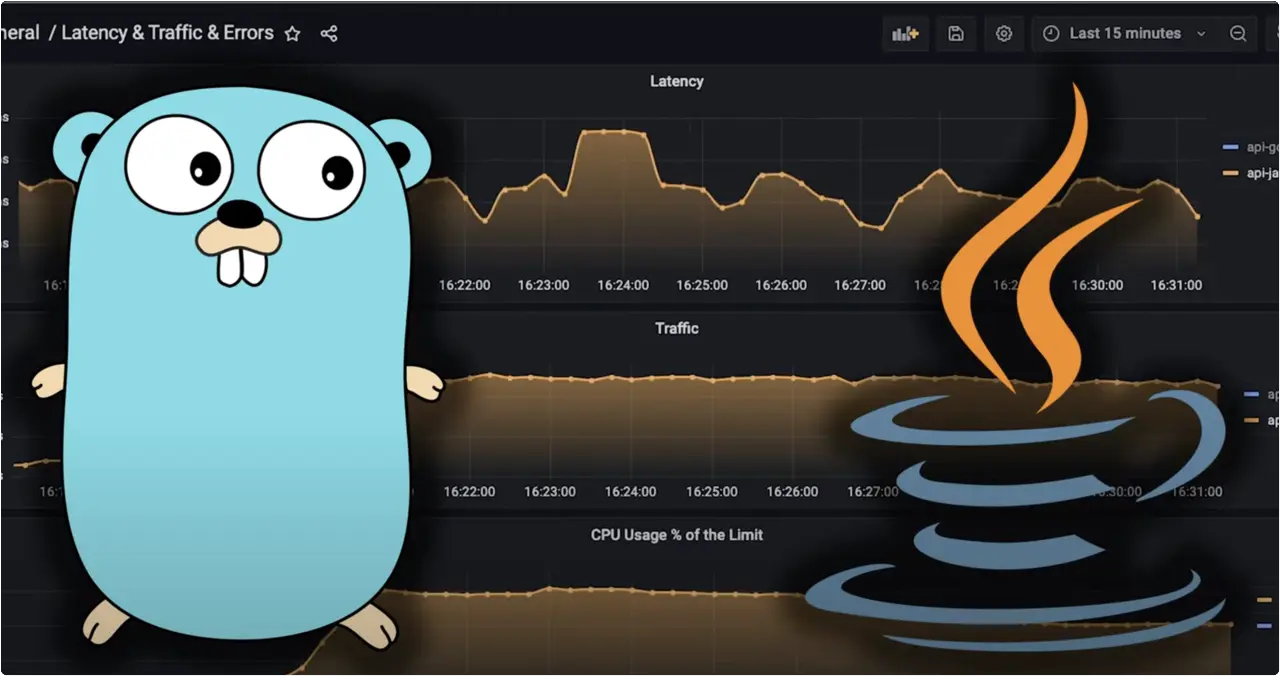GIN Vs Echo: A Guide To Choosing The Right Go Framework
- With Code Example
- February 17, 2024


Are you building a web app in Go? Picking the right framework is crucial! Two hot picks, GIN and Echo , each have their strengths and perks. This guide will break down the nitty-gritty of each: from features and speed to community buzz and what projects they shine in. By the end, you’ll be ready to pick the perfect framework for your next web-tactic creation!
Table of Contents
- Summary
- Key Points
Choosing the right framework for Go web development is crucial for project success. GIN and Echo are two popular choices, each with unique strengths. GIN prioritizes performance and simplicity, making it ideal for APIs and microservices. Echo offers extensive customization and flexibility, suitable for complex web applications with intricate routing needs. Consider project requirements, developer familiarity, and specific use cases when deciding between the two. GIN excels in high-performance applications, while Echo is great for projects requiring customization. Both frameworks have active communities, thorough documentation, and different levels of performance and feature sets. Choose wisely based on your project's needs.
💻 API Development: Gin’s lightweight and fast nature makes it an excellent choice for building APIs with an efficient routing engine and middleware support.
🏗️ Microservices Architecture: Gin’s low overhead and fast routing engine make it ideal for building microservices, especially for projects with multiple small services.
🧰 Developer Familiarity: Gin framework may be the natural choice for new projects or migrations if developers are already familiar with its syntax and features.
🚀 Rapid Prototyping: Echo’s simplicity and ease of use make it great for rapid prototyping and proof-of-concept applications.
⚙️ Middleware-Centric Applications: Echo’s middleware-centric design is suited for applications requiring extensive middleware support.
🌐 Community and Ecosystem: Echo has a growing community and ecosystem of third-party libraries and plugins for specific features and integrations.
🕰️ Real-Time Applications: Echo’s built-in support for WebSockets makes it a good choice for real-time applications like chat apps and live updates.
📋 Project Requirements: Consider project-specific requirements like performance, scalability, and feature set when choosing between Gin and Echo.
👩💻 Developer Experience: Factor in the familiarity and experience of your development team with each framework for faster development.
🤝 Community Support: Evaluate the size and activity of the community surrounding each framework for available documentation and support resources.
⚖️ Scalability: Both Gin and Echo are scalable, but consider your project’s scalability requirements to choose the best-suited framework.
🎯 Conclusion: Gin vs Echo depends on project needs, performance considerations, and developer preferences, so evaluate based on your project’s requirements and constraints. Happy coding! 🚀
Quick Comparision
Comparison between the Gin and Echo frameworks:
| Feature | Gin | Echo |
|---|---|---|
| Performance | Highly performant, optimized for speed | Fast and lightweight framework |
| Routing | Robust routing engine with dynamic routing and middleware support | Powerful routing capabilities with middleware chaining |
| Middleware | Supports middleware chaining and includes a variety of built-in middleware for common tasks | Middleware-centric design with extensive middleware support |
| Documentation | Well-documented with comprehensive guides and examples | Extensive documentation with clear explanations and examples |
| Community | Large and active community with frequent updates and contributions | Growing community with increasing adoption and community support |
| Learning Curve | Relatively low learning curve for developers familiar with web frameworks | Easy to learn, especially for developers already familiar with web development concepts |
| Flexibility | Offers flexibility in terms of customization and extension | Highly flexible with support for custom middleware and configuration options |
| Popularity | Widely used in production environments and favored by many developers | Gaining popularity due to its simplicity and performance |
| Ecosystem | Rich ecosystem with numerous third-party libraries and plugins available | Growing ecosystem with support for various integrations and extensions |
| Websocket Support | Limited support for Websockets, may require additional libraries or middleware | Comprehensive support for Websockets out of the box, including built-in middleware |
| JSON Handling | Built-in support for JSON handling and serialization | Native support for JSON handling with easy-to-use API |
| Template Rendering | Supports template rendering with HTML and text templates | Built-in support for template rendering with HTML templates and support for various template engines |
| License | MIT License | MIT License |

Introduction:
Selecting the right framework for your Go web development project is akin to choosing the perfect tool for a craftsperson. It lays the groundwork for the entire development process, impacting everything from code structure to project scalability. In this digital age where speed, efficiency, and adaptability are paramount, the decision becomes even more critical.
Importance of Choosing the Right Framework
The choice of framework significantly influences the development experience and the final outcome of a project. A well-suited framework can streamline development, enhance productivity, and ensure the scalability and maintainability of the application. Conversely, an ill-fitting framework may lead to unnecessary complexities, hindered performance, and increased development time.
In the context of Go web development, where simplicity, performance, and concurrency are core tenets, the selection process becomes even more nuanced. The framework must strike a delicate balance between providing robust features and maintaining the language’s inherent efficiency and elegance.
Introducing GIN and Echo: A Tale of Two Frameworks
Among the myriad of Go web frameworks available, GIN and Echo have emerged as prominent contenders, each with its own unique strengths and characteristics.
GIN :
As a minimalistic yet powerful framework, GIN prioritizes performance and simplicity. Built on top of net/http, it boasts blazing-fast routing and minimal overhead, making it an ideal choice for building high-performance APIs and microservices. GIN’s lightweight design and intuitive API enable developers to create robust web applications with minimal boilerplate code, ensuring rapid development without sacrificing performance.
Echo:
In contrast, Echo stands out for its flexibility and customizability. With its elegant and expressive API, Echo empowers developers to build complex web applications with ease. Offering extensive middleware support, dynamic route generation, and built-in validation, Echo provides a comprehensive toolkit for building RESTful APIs and sophisticated web applications. Its emphasis on developer productivity and flexibility makes it a preferred choice for projects requiring extensive customization and advanced features.
Navigating the Decision-Making Process
The decision between GIN and Echo hinges on a myriad of factors, including project requirements, performance considerations, and development preferences. To make an informed choice, developers must carefully evaluate the features, performance metrics, and community support of each framework, weighing the trade-offs and aligning them with the project’s goals and objectives.
In the subsequent sections of this guide, we will delve deeper into the features, use cases, and performance benchmarks of GIN and Echo, providing valuable insights to help you navigate the decision-making process and choose the framework that best suits your needs.
With a clear understanding of the importance of framework selection and an introduction to the distinctive features of GIN and Echo, let us embark on a journey to explore the nuances of these two frameworks and discover which one reigns supreme in the realm of Go web development.
Comparing Features
Routing

Routing in GIN is concise and intuitive, utilizing a minimalistic syntax that makes defining routes straightforward. Echo offers similar functionality with a flexible routing API that allows for dynamic route patterns and parameter parsing. Both frameworks support middleware, enabling developers to add pre- and post-processing logic to routes efficiently.
// GIN routing example
router := gin.Default()
router.GET("/ping", func(c *gin.Context) {
c.String(http.StatusOK, "pong")
})
// Echo routing example
e := echo.New()
e.GET("/ping", func(c echo.Context) error {
return c.String(http.StatusOK, "pong")
})
Want to learn more about routing? Watch this YouTube video
Templating
GIN provides limited support for server-side templating, primarily through the HTML rendering engine. In contrast, Echo offers greater flexibility by allowing developers to integrate with a variety of template engines, including HTML, Markdown, and JSON.
Gin Framework:
Gin framework offers built-in support for template rendering using the html/template package from the Go standard library. Here’s how you can use
- Template Parsing: Gin provides a
LoadHTMLGlobfunction to load HTML templates from a directory. You can use this function to parse and load templates:
// Load HTML templates
router := gin.Default()
router.LoadHTMLGlob("templates/*")
- Rendering Templates: Once templates are loaded, you can render them in route handlers using the
HTMLmethod:
// Render HTML template
router.GET("/", func(c *gin.Context) {
// Render the "index.html" template
c.HTML(http.StatusOK, "index.html", gin.H{
"title": "Welcome to My Website",
})
})
- Passing Data to Templates: You can pass data to templates using the
gin.Hmap or by passing a struct:
type User struct {
Name string
Email string
}
router.GET("/user", func(c *gin.Context) {
// Pass data to the "user.html" template
user := User{Name: "John Doe", Email: "[email protected]"}
c.HTML(http.StatusOK, "user.html", gin.H{
"user": user,
})
})
Echo Framework:
Echo framework also supports template rendering with the ability to use various template engines such as HTML, Markdown, and others. Here’s how you can use template rendering in Echo:
- Template Rendering Setup: Echo provides a
Rendermethod to set up template rendering:
// Set up template rendering
e := echo.New()
e.Renderer = renderer.NewRenderer("templates")
- Rendering Templates: After setting up template rendering, you can render templates in route handlers using the
Rendermethod:
// Render HTML template
e.GET("/", func(c echo.Context) error {
// Render the "index.html" template
return c.Render(http.StatusOK, "index.html", map[string]interface{}{
"title": "Welcome to My Website",
})
})
- Passing Data to Templates: Similar to Gin, you can pass data to templates using a map or a struct:
type User struct {
Name string
Email string
}
e.GET("/user", func(c echo.Context) error {
// Pass data to the "user.html" template
user := User{Name: "John Doe", Email: "[email protected]"}
return c.Render(http.StatusOK, "user.html", map[string]interface{}{
"user": user,
})
})
Comparison:
Both Gin and Echo provide similar functionality for template rendering, allowing developers to easily render HTML templates and pass data to them. The main difference lies in the setup and configuration syntax, with Gin using its own HTML method and Echo using the Render method. However, the end result is the same, with both frameworks offering robust support for template rendering in Go web applications. Developers can choose between Gin and Echo based on their personal preferences and project requirements.
Validation

Both GIN and Echo offer built-in validation capabilities for handling user input. However, Echo provides more extensive support through its integration with popular validation libraries like Go Validator and go-playground/validator.
Validation in Gin:
Gin doesn’t have built-in validation capabilities out of the box. However, developers can easily integrate third-party validation libraries such as go-playground/validator or asaskevich/govalidator to handle input validation in their Gin applications.
Here’s an example of using the go-playground/validator library with Gin for input validation:
package main
import (
"github.com/gin-gonic/gin"
"github.com/go-playground/validator/v10"
)
type User struct {
Username string `json:"username" validate:"required"`
Email string `json:"email" validate:"required,email"`
}
func main() {
r := gin.Default()
// Initialize validator
validate := validator.New()
r.POST("/register", func(c *gin.Context) {
var user User
if err := c.ShouldBindJSON(&user); err != nil {
c.JSON(400, gin.H{"error": err.Error()})
return
}
// Validate user input
if err := validate.Struct(user); err != nil {
c.JSON(400, gin.H{"error": err.Error()})
return
}
// Process valid user data
c.JSON(200, gin.H{"message": "User registered successfully"})
})
r.Run(":8080")
}
Validation in Echo:
Echo offers built-in validation capabilities through its echo.Validator interface, allowing developers to define custom validation rules and error messages.
Here’s an example of using Echo’s built-in validation middleware for input validation:
package main
import (
"github.com/labstack/echo/v4"
"github.com/labstack/echo/v4/middleware"
"gopkg.in/go-playground/validator.v9"
)
type User struct {
Username string `json:"username" validate:"required"`
Email string `json:"email" validate:"required,email"`
}
func main() {
e := echo.New()
// Initialize validator
e.Validator = &CustomValidator{validator: validator.New()}
e.POST("/register", func(c echo.Context) error {
var user User
if err := c.Bind(&user); err != nil {
return err
}
// Validate user input
if err := c.Validate(&user); err != nil {
return err
}
// Process valid user data
return c.JSON(200, map[string]string{"message": "User registered successfully"})
})
e.Logger.Fatal(e.Start(":8080"))
}
// CustomValidator implements echo.Validator interface
type CustomValidator struct {
validator *validator.Validate
}
// Validate validates a struct
func (cv *CustomValidator) Validate(i interface{}) error {
if err := cv.validator.Struct(i); err != nil {
return echo.NewHTTPError(400, err.Error())
}
return nil
}
In this example, the CustomValidator struct implements the echo.Validator interface, allowing custom validation rules to be defined using the go-playground/validator library.
Overall, both Gin and Echo provide options for input validation, with Gin relying on third-party libraries and Echo offering built-in validation capabilities. Developers can choose the approach that best fits their project requirements and preferences.
Database Interaction

GIN and Echo provide seamless integration with databases, allowing developers to interact with SQL and NoSQL databases effortlessly. While GIN offers basic database functionality, Echo’s flexibility enables more advanced database operations and ORM integrations.
Let’s compare database interaction in Gin and Echo frameworks:
Database Interaction in Gin:
Gin does not come with built-in support for database interaction, but it provides flexibility for developers to choose their preferred database libraries and ORM frameworks. Developers commonly use popular libraries such as gorm, sqlx, or database/sql to interact with databases in Gin applications.
Here’s an example of using the gorm library to perform CRUD operations with MySQL in a Gin application:
package main
import (
"github.com/gin-gonic/gin"
"gorm.io/driver/mysql"
"gorm.io/gorm"
)
type User struct {
ID uint `gorm:"primaryKey"`
Username string `gorm:"unique"`
Email string
}
func main() {
// Connect to MySQL database
dsn := "user:password@tcp(127.0.0.1:3306)/dbname?charset=utf8mb4&parseTime=True&loc=Local"
db, err := gorm.Open(mysql.Open(dsn), &gorm.Config{})
if err != nil {
panic("Failed to connect to database")
}
// Auto-migrate the schema
db.AutoMigrate(&User{})
// Initialize Gin router
r := gin.Default()
// Handler to create a new user
r.POST("/users", func(c *gin.Context) {
var user User
if err := c.BindJSON(&user); err != nil {
c.JSON(400, gin.H{"error": err.Error()})
return
}
db.Create(&user)
c.JSON(200, user)
})
// Handler to get all users
r.GET("/users", func(c *gin.Context) {
var users []User
db.Find(&users)
c.JSON(200, users)
})
// Run Gin server
r.Run(":8080")
}
Database Interaction in Echo:
Similar to Gin, Echo does not provide built-in database interaction capabilities, but it allows developers to integrate their preferred database libraries or ORMs. Common choices include gorm, sqlx, or database/sql.
Here’s an example of using the gorm library to interact with a MySQL database in an Echo application:
package main
import (
"github.com/labstack/echo/v4"
"gorm.io/driver/mysql"
"gorm.io/gorm"
)
type User struct {
ID uint `gorm:"primaryKey"`
Username string `gorm:"unique"`
Email string
}
func main() {
// Connect to MySQL database
dsn := "user:password@tcp(127.0.0.1:3306)/dbname?charset=utf8mb4&parseTime=True&loc=Local"
db, err := gorm.Open(mysql.Open(dsn), &gorm.Config{})
if err != nil {
panic("Failed to connect to database")
}
// Auto-migrate the schema
db.AutoMigrate(&User{})
// Initialize Echo instance
e := echo.New()
// Handler to create a new user
e.POST("/users", func(c echo.Context) error {
var user User
if err := c.Bind(&user); err != nil {
return err
}
db.Create(&user)
return c.JSON(200, user)
})
// Handler to get all users
e.GET("/users", func(c echo.Context) error {
var users []User
db.Find(&users)
return c.JSON(200, users)
})
// Start the Echo server
e.Logger.Fatal(e.Start(":8080"))
}
In both examples, we’re using the gorm
library to interact with a MySQL database, performing CRUD operations within the Gin and Echo applications. Developers can choose their preferred database library or ORM framework based on factors such as performance, ease of use, and compatibility with their application requirements.
Performance

Comparing the performance of Gin and Echo frameworks can be complex and depends on various factors such as the specific use case, server configuration, and application implementation. However, I can provide some general insights into their performance characteristics.
Gin Performance:
Gin is known for its high performance and low overhead. It achieves this by minimizing unnecessary features and focusing on essential functionality. Gin’s performance benefits from its efficient routing engine and lightweight design, which make it well-suited for building high-performance web applications, APIs, and microservices.
Gin achieves its speed by using httprouter as its default router, which is a high-performance HTTP request router. Additionally, Gin emphasizes the use of fewer reflection operations compared to other frameworks, which can contribute to improved performance.
Echo Performance:
Echo is also designed for high performance and aims to be one of the fastest HTTP frameworks available for Go. It achieves this through its minimalist design, efficient routing, and middleware implementation. Echo’s performance benefits from its use of a radix tree-based router, which is highly optimized for fast route matching.
Echo prioritizes speed and simplicity, avoiding unnecessary overhead and providing developers with a lightweight framework that can handle high loads efficiently.
Benchmarking:
When comparing the performance of Gin and Echo, developers often conduct benchmark tests using tools like Apache Bench (ab), wrk, or hey. These tests typically measure metrics such as throughput, response times, and resource utilization under various load conditions.
Benchmarking results can vary depending on factors such as server hardware, network configuration, and application complexity. It’s essential to conduct thorough benchmark tests in a real-world scenario to determine which framework performs better for a specific use case.
Community and Support

Both GIN and Echo boast active and supportive communities, with extensive documentation, tutorials, and community-contributed resources. However, GIN’s larger user base and longer history may result in more readily available resources and plugins.
3. Use Cases
GIN
GIN is well-suited for performance-critical applications, such as APIs and microservices, where speed and efficiency are paramount. Its minimalistic design and low overhead make it an excellent choice for simple web applications that prioritize raw performance.
Echo
Echo shines in scenarios requiring extensive customization and flexibility, such as building RESTful APIs or complex web applications with intricate routing requirements. Its rich feature set and robust middleware support make it ideal for projects where customizability is a top priority.
Deciding
Deciding whether to use Gin or Echo depends on various factors, including project requirements, developer familiarity, and specific use cases. Here are some considerations for where to use each framework:
When to Use Gin:
High-Performance Web Applications: Gin is well-suited for building high-performance web applications that require fast response times and efficient routing. Its minimalist design and focus on speed make it a popular choice for performance-critical applications.
API Development: Gin’s lightweight and fast nature make it an excellent choice for building APIs. Its efficient routing engine and middleware support enable developers to create RESTful APIs with minimal overhead.
Microservices Architecture: Gin’s low overhead and fast routing engine make it ideal for building microservices. Its simplicity and performance make it a compelling option for projects with multiple small services that need to communicate with each other.
Developer Familiarity: If developers are already familiar with the Gin framework or prefer its syntax and features, it may be the natural choice for new projects or when migrating existing applications.
When to Use Echo:
Rapid Prototyping: Echo’s simplicity and ease of use make it an excellent choice for rapid prototyping and building proof-of-concept applications. Its minimalistic design and intuitive API enable developers to quickly get up and running with new projects.
Middleware-Centric Applications: Echo’s middleware-centric design makes it well-suited for applications that require extensive middleware support. Developers can easily plug in middleware for tasks such as authentication, logging, and error handling, making it flexible for a wide range of use cases.
Community and Ecosystem: Echo has a growing community and ecosystem of third-party libraries and plugins. If developers require specific features or integrations that are available in the Echo ecosystem, it may be the preferred choice for their project.
Real-Time Applications: Echo’s built-in support for WebSockets and its efficient routing engine make it a good choice for real-time applications such as chat applications, live updates, and collaborative tools.
Considerations for Both Frameworks:
Project Requirements: Consider the specific requirements of your project, including performance, scalability, and feature set, when choosing between Gin and Echo.
Developer Experience: Take into account the experience and familiarity of your development team with each framework. Choosing a framework that developers are comfortable with can lead to faster development and fewer implementation issues.
Community Support: Consider the size and activity of the community surrounding each framework, as well as the availability of documentation, tutorials, and support resources.
Scalability: Both Gin and Echo are designed to be scalable, but consider the scalability requirements of your project and whether one framework may be better suited for your scalability goals.
Ultimately, the choice between GIN vs Echo depends on the specific needs and goals of your project, as well as the preferences and expertise of your development team. Both frameworks offer excellent performance and flexibility, so it’s essential to evaluate them based on your project’s requirements and constraints.
4. Conclusion
In conclusion, GIN vs Echo are both powerful frameworks with distinct strengths and weaknesses. When choosing between them, consider your project’s requirements, performance considerations, and development preferences. By evaluating each framework’s features, performance, and community support, you can select the one that best aligns with your project goals and development philosophy.
Remember, there is no one-size-fits-all solution, and the optimal framework may vary depending on the specifics of your project. Explore the documentation, experiment with code examples, and leverage community resources to make an informed decision.
Happy coding!
Additional Resources:

Related Posts

Routing and Middleware in Fiber Golang
In web development, creating a web application that effectively routes and manages various tasks is essential. Routing determines how incoming requests are handled, and middleware plays a pivotal role in performing tasks like authentication, logging, and request parsing.





